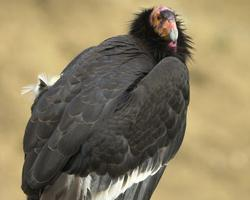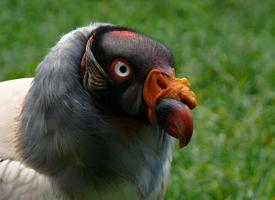
Biologická data
| Délka života | 50 r |
|---|
Stav ohrožení
| Ohrožen |
Popis zvířete
The California condor (Gymnogyps californianus) is a magnificent bird, emblematic of the wild and rugged terrains of the American West, particularly California. This species is the largest North American land bird, boasting an impressive wingspan that can exceed 9 feet (about 2.7 meters), which facilitates its graceful soaring and gliding across vast distances without much flapping. The sight of a California condor riding the thermals is a testament to the bird's majesty and has inspired conservation efforts to save it from the brink of extinction.Adult California condors are primarily black with striking white patches of feathers beneath their wings, which become prominently visible during flight. Their heads and necks are nearly featherless, revealing skin that can flush and change color in response to the bird's emotional state, ranging from pink to bright red and orange. This lack of feathers on the head and neck is an adaptation for hygiene, preventing remnants of carrion (their primary food source) from adhering to their skin. Juvenile condors, in contrast, have dark grayish-black heads, and their bodies are mottled with patches of white and brown until they mature.
The California condor is a scavenger, feeding almost exclusively on the carcasses of dead animals such as deer, cattle, and sheep. This diet places them at the top of the food chain and makes them an essential component of their ecosystem, helping to clean the environment by disposing of carrion that could otherwise spread disease. Their keen eyesight allows them to spot potential meals from high altitudes as they soar over vast terrains.
Historically, California condors roamed across much of North America, but by the mid-20th century, their numbers had dwindled alarmingly due to habitat destruction, lead poisoning from ingested spent ammunition, and poaching. By the 1980s, the situation had become so dire that all remaining wild individuals were captured in an attempt to save the species through a breeding program in captivity. This controversial yet ultimately successful effort has allowed for the gradual reintroduction of these birds into their natural habitats in California, Arizona, and Baja California, Mexico.
Despite these efforts, the California condor remains one of the world's most critically endangered bird species. Conservation initiatives continue to focus on habitat preservation, public education, and addressing the ongoing threat of lead poisoning by advocating for the use of non-lead ammunition by hunters within the condor's range. The survival of the California condor represents a beacon of hope for conservationists, symbolizing the potential for humanity to rectify past mistakes and work towards a more sustainable coexistence with the natural world.
The California condor's life history is as fascinating as its recovery story. These birds are known for their long lifespan, capable of living up to 60 years in the wild. They reach sexual maturity at about 5 to 6 years of age but breed slowly, usually raising only one chick every two years. This slow reproduction rate is one of the factors that has made their population recovery challenging. Condors are social birds, often seen roosting and flying in groups, and they exhibit complex behaviors, including communal feeding and social interactions that suggest a high level of intelligence and adaptability.
The ongoing conservation of the California condor is a multifaceted endeavor that involves collaboration between government agencies, non-profit organizations, and local communities. It is a testament to the resilience of nature and the importance of collective human effort in preserving our planet's biodiversity. The continued existence of the California condor in the wild serves not only as a reminder of what can be lost but also of what can be regained through dedication, science, and compassion.
Podobná zvířata
Nové fotografie zvířat
Top 10 zvířat
- Dolphin gull (Leucophaeus scoresbii)
- Stone loach (Barbatula barbatula)
- Diana monkey (Cercopithecus diana)
- Japanese macaque (Macaca fuscata)
- Greek tortoise (Testudo graeca)
- Galápagos tortoise (Geochelone nigra complex)
- Moustached guenon (Cercopithecus cephus)
- Russian tortoise (Testudo horsfieldii)
- Galápagos penguin (Spheniscus mendiculus)
- Common flying dragon (Draco volans)


